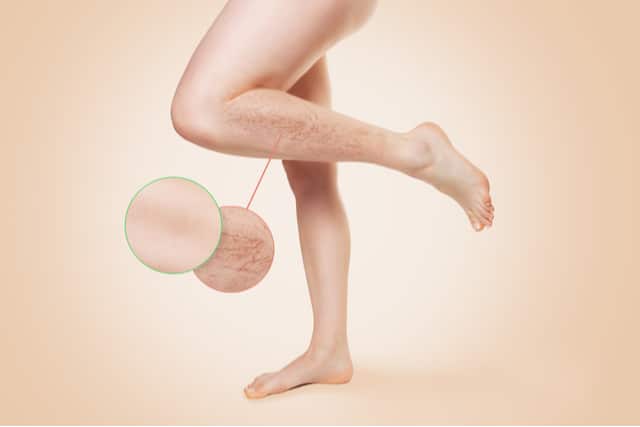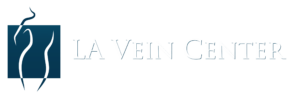Varicose veins are a common problem that results from faulty valves in certain veins, usually in the legs. Because they are distended and filled with too much blood in certain sections, these veins can become cosmetically problematic. Varicose veins can also cause a number of uncomfortable symptoms, such as discoloration of the skin, aching, cramping, and a sensation of heaviness in the legs.

The only way to remedy varicose veins is to remove them or close them off. Long ago, veins were removed in a relatively complicated “stripping” procedure. Today, we have multiple modalities that allow us to remedy problematic veins. We are pleased to offer several options, including endovenous radiofrequency ablation.
What Is Radiofrequency Ablation?
Endovenous radiofrequency ablation is a minimally invasive treatment for venous reflux, the underlying cause of varicose veins and other venous conditions. The modality works by applying heat to the delicate lining of the affected vein. The heat stimulates the formation of mild scar tissue, which in turn forces the vein to close. The vein cannot reopen. In time, it dissolves and the body absorbs it. The blood that once flowed through that vein redirects to a nearby vein to maintain adequate circulation out of the lower extremities. The procedure is performed in the office using a local anesthetic. To treat the vein, the doctor applies radiofrequency energy via a thin catheter that is inserted through a tiny incision in the skin. Depending on the number of veins treated, the process may take less than an hour.
What Parts Of The Body Does Radiofrequency Ablation Treat?
Radiofrequency ablation is a minimally invasive treatment for varicose veins. Varicose veins occur when faulty valves allow blood to accumulate in a section of a vein. Veins are the vehicles for blood to travel back to the heart after reaching peripheral areas of the body. Because the veins in the legs work against the force of gravity to push blood upward, the legs are the most common area in which we see varicose veins. Therefore, radiofrequency ablation most often treats swollen veins in the legs.
Who Is A Candidate?
A vein specialist takes several factors into consideration when developing a recommended treatment plan. These include the size and location of the distended vein, skin tone, and the type of vein targeted for treatment. In general, people who would be considered good candidates for the antiquated vein stripping procedure are good candidates for this non-surgical alternative. Endovenous radiofrequency ablation is a good treatment option for varicose veins, which often form in an area of the thigh or calf of the leg. Smaller veins and spider veins may respond well to other treatment options, such as sclerotherapy.
How Can I Prepare For Treatment?
There isn’t much to do to prepare for endovenous radiofrequency ablation. Prior to the procedure, you may be advised to avoid medications and supplements that thin the blood, starting a week or two before the appointment. It can be beneficial to drink plenty of water in the days leading up to the procedure and to plan to wear loose-fitting clothing to the appointment. The doctor may also advise you to purchase compression stockings before your treatment and to bring them with you to the office.
Is Radiofrequency Ablation Painful?
This procedure is performed using a local anesthetic that numbs the tissue around the vein. Veins themselves do not have nerve endings so do not send pain signals when the small catheter is inserted. At most, patients say they experience a minor pinching sensation when the local anesthetic is administered. After that point, the remainder of the procedure can be conducted comfortably. The discomfort after radiofrequency ablation for varicose veins is also considered very mild and tolerable.
Is There Recovery Involved?
Generally, patients can comfortably resume most normal activities right away after endovenous radiofrequency ablation. We advise patients to restrict strenuous activity and heavy lifting for about one week following vein treatment. Compression stockings should also be worn during waking hours for that amount of time. If soreness or tenderness occurs, you may take an over-the-counter pain reliever like acetaminophen. Minor post-treatment side effects like soreness and swelling can also be mitigated by elevating the legs and applying ice for 15 minutes every few hours for one or two days.
How Often Can I Receive Radiofrequency Ablation?
Endovenous radiofrequency ablation successfully eliminates most varicose veins in just one treatment. The closed veins do not reopen. However, like all vein treatments, radiofrequency ablation cannot eliminate the risk of new varicose veins forming in other areas of the legs. If new veins form and become cosmetically or physically troublesome, it may be possible to treat them with the same modality. Dr. Lee performs a thorough evaluation on all veins to determine the most effective treatment for optimal results.
What Is Chronic Venous Insufficiency?
When you see spider veins and varicose veins on your legs and ankles, you might think only of what is visible to the eye. Chronic venous insufficiency is what's behind those problem veins. This condition occurs when, due to weakening or other factors, the valves that prevent blood from backing up in a part of a vein don't fully close. With each pump, then, some of the blood making its way back to the heart moves backward. This is referred to as reflux. Where there is blood pooling, the vein swells, resulting in visible discoloration, protrusion, and other symptoms. Chronic venous insufficiency isn't just a couple of visible veins here and there, it also causes other symptoms, including leg cramps or a sense of heaviness, discoloration or ulcers on the skin, aching, and more.
Why Do You Treat Varicose Veins with Radiofrequency Ablation?
Once valves in a vein stop working, the vein must be closed off to prevent further blood stagnation and distention. There is no way to repair the valve to make it work again. Historically, dysfunctional veins have been removed surgically in a procedure referred to as vein stripping. Alternatively, veins may have been closed using sclerotherapy, a service that Dr. Lee regularly performs here at L.A. Vein Center. Radiofrequency ablation is a newer method of treating veins that may be more convenient or suitable for some patients. It works without surgery, large incisions, or injection, closing the vein by delivering radiofrequency energy to the affected area. Delivered using a tiny catheter-type instrument, radiofrequency causes the walls of the vein to stick together, forcing the vein to close.
How Is Radiofrequency Ablation Different from Vein Stripping?
The vein stripping procedure is rarely done anymore. We have far more conservative methods of removing severe varicose veins without incurring significant side effects. In the vein stripping procedure, the doctor would make an incision in the groin area and tie off the vein. A special instrument would then be used to pull the vein out of a second incision located near the calf. In contrast, radiofrequency ablation closes off the vein without surgery and multiple incisions. The vein isn't removed surgically but simply closed. The body takes care of the rest!
How Is Radiofrequency Ablation Different from Laser Ablation Treatment?
Radiofrequency ablation is similar to laser ablation for non-working veins. Both procedures use a type of thermal energy to cause a reaction. Laser energy causes the blood in the vein to heat up to a boiling point. This creates a steam bubble in the vein, resulting in damage to the vein walls and subsequent collapse. In this process, a great deal of heat can be created in the vein. Radiofrequency energy delivered into the vein causes collagen in the vein walls to contract. The blood is not overheated. The vein collapses due to the contraction of collagen.
What Can I Expect After My Radiofrequency Ablation Procedure?
One of the benefits of radiofrequency ablation vein treatment is that you can quickly get back to most of your normal activities. You can begin walking as soon as the day of your treatment and should do so to support good circulation out of your legs. You can expect to begin noticing an improvement in the appearance of the vein in one to two weeks of your procedure, and should experience minimal bruising and swelling following treatment To prevent these side effects, you should keep your physical activity to a low level, no strenuous exercise, for a couple of weeks.
Contact Us Today!
Vein treatments have expanded over time, providing us with new opportunities to gently, efficiently get rid of unattractive, uncomfortable veins. To learn more about endovenous radiofrequency ablation and other varicose vein and spider vein treatments, contact LA Vein Center at (818) 325-0400.
Contact our Los Angeles office to learn more about our services, or to make an appointment.

